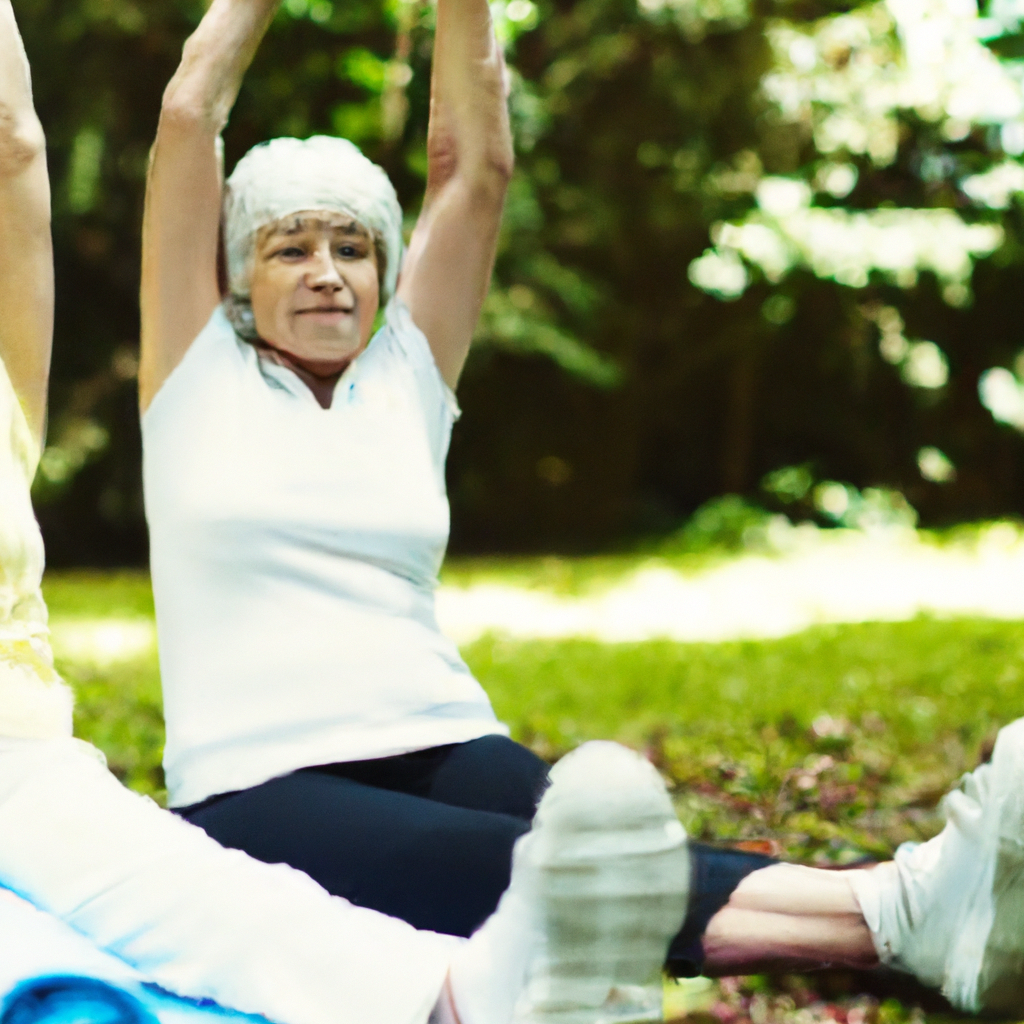Are you an older adult looking to stay fit and healthy? Look no further! In this article, we will explore the fascinating world of senior fitness and how it caters to the specific health and fitness needs of older adults. Discover the various exercises, programs, and tips tailored to ensure your overall well-being and vitality for years to come. With a focus on empowering seniors to live their best lives, senior fitness is the key to unlocking a world of health and happiness. So, let’s dive in and discover how you can achieve and maintain a fit and active lifestyle in your golden years!
Reducing the Risk of Chronic Diseases
As you age, it becomes increasingly important to prioritize your health and reduce the risk of chronic diseases. One of the most effective ways to achieve this is through regular exercise. Engaging in physical activities tailored to seniors can have numerous benefits for your overall well-being and help you maintain a higher quality of life.
Importance of Exercise for Seniors
Exercise plays a vital role in promoting healthy aging and preventing chronic diseases. For seniors, incorporating regular physical activity into their routine can help improve cardiovascular health, maintain muscle mass, enhance flexibility and joint mobility, promote balance and fall prevention, and even boost cognitive function and mental well-being.
Types of Physical Activities for Seniors
When it comes to physical activities for seniors, there is a wide range of options available. Depending on your interests, abilities, and any pre-existing medical conditions, you can choose from activities such as walking, swimming, cycling, Tai Chi, yoga, strength training, and more. It’s essential to find activities that you enjoy and that align with your personal preferences to ensure long-term adherence.
Benefits of Regular Exercise for Seniors
Engaging in regular exercise as a senior offers numerous benefits that can significantly improve your overall health and well-being. Some of these benefits include increased cardiovascular fitness, improved muscle strength and endurance, enhanced flexibility and joint mobility, better balance and coordination, reduced risk of falls, improved cognitive function, reduced symptoms of anxiety and depression, boosted mood, and increased social interaction and engagement.
Exercise Recommendations for Older Adults
To reap the full benefits of exercise and ensure your safety, it’s important to follow specific exercise recommendations tailored for older adults. The American Heart Association and the American College of Sports Medicine recommend at least 150 minutes of moderate-intensity aerobic activity per week or 75 minutes of vigorous-intensity aerobic activity. Additionally, they suggest incorporating moderate- to high-intensity strength training exercises targeting major muscle groups at least two days per week.
Maintaining Healthy Body Composition
Maintaining a healthy body composition becomes increasingly challenging as we age. Changes in metabolism and hormonal balance can lead to a decline in muscle mass and an increase in body fat. However, with proper nutrition and regular strength training, seniors can effectively preserve muscle mass and promote a healthy body composition.
How Body Composition Changes with Age
As you age, your body undergoes various changes that can affect your body composition. One significant change is the gradual loss of muscle mass, known as sarcopenia. Sarcopenia is driven by factors such as hormonal changes, reduced physical activity, and poor nutrition. Additionally, there is a tendency for an increase in body fat, particularly around the abdominal area, due to a slower metabolic rate.

This image is property of images.pexels.com.
Importance of Strength Training for Seniors
Strength training is a crucial component of maintaining a healthy body composition as a senior. It helps counteract the age-related decline in muscle mass and strength, promoting functional independence and overall well-being. By engaging in regular strength training exercises, you can increase muscle mass, improve bone density, enhance metabolism, and reduce the risk of chronic conditions such as osteoporosis and diabetes.
Nutrition Tips for Seniors
In addition to strength training, proper nutrition is vital for maintaining a healthy body composition. As you age, your nutrient needs may change, and it’s important to ensure you’re fueling your body with the right nutrients. Focus on consuming a balanced diet rich in lean protein, fruits, vegetables, whole grains, and healthy fats. Stay hydrated and consult with a registered dietitian or healthcare professional to tailor your nutrition plan to your specific needs.
Best Exercises for Maintaining Muscle Mass
When it comes to maintaining muscle mass, certain exercises are particularly beneficial for seniors. Resistance training, using either weights or resistance bands, is a highly effective way to build and maintain muscle mass. Include exercises that target major muscle groups, such as squats, lunges, chest presses, bicep curls, and tricep dips. It’s important to start with lighter weights and gradually increase as you build strength and confidence.
Improving Cardiovascular Health
Maintaining cardiovascular health is essential for seniors to enhance overall well-being and reduce the risk of heart disease and other related conditions. Regular cardiovascular exercise can help improve heart and lung function, lower blood pressure, reduce the risk of strokes, and increase overall endurance.
Cardiovascular Health and Aging
As you age, your cardiovascular system undergoes changes that can affect your heart health. Blood vessels may become less flexible, leading to increased blood pressure. The heart muscle may also weaken, causing decreased heart efficiency. Engaging in regular cardiovascular exercise can help counteract these age-related changes, aiding in maintaining healthy cardiovascular function.
Cardiovascular Exercise Recommendations for Seniors
The American Heart Association recommends at least 150 minutes of moderate-intensity aerobic activity or 75 minutes of vigorous-intensity aerobic activity per week for seniors. Examples of moderate-intensity activities include brisk walking, water aerobics, and cycling, while vigorous-intensity activities include jogging, swimming laps, and playing tennis. It’s important to choose activities that you enjoy and that are suitable for your fitness level and any underlying health conditions.

This image is property of images.pexels.com.
Benefits of Cardiovascular Exercise for Seniors
Regular cardiovascular exercise offers a multitude of benefits for seniors. It helps strengthen the heart muscle, improves blood circulation, lowers blood pressure, reduces the risk of heart disease and stroke, and promotes overall cardiovascular fitness. Additionally, cardiovascular exercise can help manage weight, control blood sugar levels, improve sleep quality, boost mood, and enhance mental well-being.
Precautions for Seniors Performing Cardiovascular Exercise
While cardiovascular exercise is generally safe for most older adults, it’s important to take certain precautions to ensure your safety. If you have any underlying health conditions or are new to exercise, it’s advisable to consult with your healthcare professional before starting a new exercise program. Start slowly and gradually increase the intensity and duration of your workouts. Listen to your body, stop if you experience any concerning symptoms, and seek medical attention if necessary.
Enhancing Flexibility and Joint Mobility
Maintaining flexibility and joint mobility is essential for seniors to perform daily activities with ease and reduce the risk of injuries. Regular stretching exercises can help counteract the effects of aging on joint flexibility, enhance range of motion, relieve stiffness, and improve overall physical function.
Effects of Aging on Flexibility and Joint Mobility
Aging can lead to a gradual decrease in flexibility and joint mobility due to factors such as changes in connective tissues, decreased muscle elasticity, and the development of joint problems like arthritis. This loss in flexibility can make simple activities more challenging and increase the risk of falls and injuries. However, with regular stretching exercises, you can effectively improve and maintain your flexibility and joint mobility.
Stretching Exercises for Seniors
Incorporating stretching exercises into your fitness routine is a great way to enhance flexibility and joint mobility. Focus on performing both static and dynamic stretches that target major muscle groups and joints. Some examples include neck stretches, shoulder rolls, hamstring stretches, calf stretches, and ankle rotations. Remember to warm up your muscles before stretching and perform each stretch slowly and gently, avoiding any pain or discomfort.
Benefits of Flexibility Training for Seniors
Regular flexibility training offers numerous benefits for seniors. It helps improve joint range of motion, maintain functional independence, prevent muscle imbalances and postural problems, enhance athletic performance, and reduce the risk of falls and injuries. Additionally, stretching exercises can help relieve muscle tension, promote relaxation, and improve overall body awareness and mindfulness.

This image is property of images.pexels.com.
Preventing Joint Stiffness and Improving Range of Motion
By incorporating regular flexibility training into your routine, you can effectively prevent joint stiffness and improve your range of motion. Engaging in stretching exercises not only helps maintain the health and mobility of your joints but also ensures that you can continue to perform daily activities with ease and confidence. Remember to prioritize proper form and technique during stretching exercises to maximize their benefits.
Promoting Balance and Fall Prevention
Maintaining good balance becomes increasingly important as you age, as it can significantly reduce the risk of falls and related injuries. Engaging in balance exercises can help improve stability, coordination, and proprioception, promoting overall safety and well-being for seniors.
Age-Related Decline in Balance
As you age, your balance naturally tends to decline due to various factors. Changes in vision, hearing, muscle strength, and sensation play a role in the age-related decline in balance. Poor balance can increase the risk of falls, which can have severe consequences for older adults. However, by regularly incorporating balance exercises into your fitness routine, you can improve your balance and reduce the risk of falls.
Balance Exercises for Seniors
There are several balance exercises that seniors can perform to enhance their stability and coordination. Examples include standing on one leg, walking heel-to-toe, sideways walking, toe stands, and yoga poses such as tree pose or warrior pose. It’s essential to start with exercises that are suitable for your current balance level and gradually progress as you gain strength and confidence.
Importance of Fall Prevention Strategies
Fall prevention is a critical aspect of senior fitness, as falls can result in severe injuries that may negatively impact quality of life. Alongside balance exercises, incorporating fall prevention strategies into your daily life can significantly reduce the risk of falls. This includes ensuring proper lighting, removing clutter and tripping hazards, using assistive devices if necessary, and periodically reviewing medication side effects that may affect balance.
Tips for Improving Balance and Reducing Fall Risk
Improving balance and reducing fall risk requires consistent effort and attention. In addition to balance exercises and fall prevention strategies, there are several other tips to consider. Maintain regular eye check-ups to ensure optimal vision, review your medications with your healthcare professional to identify any potential balance-related side effects, and engage in activities that promote core strength and stability, such as Pilates and yoga. Remember to always prioritize safety and use assistive devices if needed.
Maintaining Cognitive Function and Mental Well-being
Taking care of your cognitive function and mental well-being is just as important as maintaining physical fitness as a senior. Engaging in brain-boosting exercises, managing stress and anxiety through exercise, and staying socially engaged can have a profound impact on your cognitive health and overall well-being.

The Relationship Between Physical Activity and Cognitive Function
Mounting evidence suggests that there is a strong relationship between physical activity and cognitive function. Regular exercise has been shown to enhance brain health, improve memory and attention, enhance cognitive processing speed, and reduce the risk of cognitive decline and neurodegenerative diseases such as Alzheimer’s. By incorporating brain-boosting exercises into your fitness routine, you can significantly improve your cognitive function as you age.
Brain-Boosting Exercises for Seniors
Several types of exercises specifically target cognitive function and brain health. Aerobic exercises such as brisk walking, dancing, and swimming have been shown to have positive effects on cognitive function. Additionally, activities that require mental engagement, such as puzzles, Sudoku, reading, learning a new skill or language, and playing musical instruments, can also help maintain and enhance cognitive function. Make sure to incorporate a variety of both physical and mentally stimulating exercises into your routine.
Managing Stress and Anxiety Through Exercise
Stress and anxiety can take a toll on your mental well-being, and exercise can be a powerful tool for managing these feelings as a senior. Engaging in regular physical activity releases endorphins, which are natural mood boosters. Whether it’s going for a walk in nature, practicing yoga or meditation, or participating in a fun exercise class, find activities that help you alleviate stress and anxiety and incorporate them into your routine.
Social Engagement for Cognitive and Mental Health
Maintaining social connections and engaging in meaningful social activities is crucial for your cognitive function and mental well-being. Participating in group exercise classes, joining community clubs or organizations, volunteering, or simply socializing with friends and family can have a positive impact on your overall health. Social engagement promotes brain health, reduces feelings of loneliness and isolation, and enhances your sense of purpose and well-being.
Adapting Exercise Programs for Seniors with Medical Conditions
If you have pre-existing medical conditions, it’s important to adapt your exercise program accordingly to ensure your safety and well-being. Consulting with healthcare professionals, making necessary exercise modifications, and taking safety considerations into account are key in managing your fitness routine effectively.
Common Medical Conditions in Older Adults
As you age, the likelihood of developing certain medical conditions increases. Common conditions among older adults include arthritis, osteoporosis, diabetes, heart disease, hypertension, chronic obstructive pulmonary disease (COPD), and joint replacements. Each of these conditions requires specific attention and modifications when it comes to exercise.

Exercise Modifications for Seniors with Chronic Diseases
When managing chronic diseases, exercise modifications are often necessary to accommodate the specific needs and limitations associated with each condition. For example, individuals with arthritis may benefit from low-impact exercises that minimize joint stress, such as swimming or water aerobics. Those with heart disease may require a gradual progression of exercise intensity and regular monitoring of heart rate and blood pressure. It’s crucial to work closely with your healthcare professional or a qualified exercise specialist to develop a safe and effective exercise plan tailored to your medical condition.
Consulting with Healthcare Professionals
Before starting or modifying any exercise program, it’s important to consult with your healthcare professional. They can provide valuable insights into your specific medical condition, help determine appropriate exercise guidelines, and offer guidance on any necessary modifications. Medical professionals such as doctors, physiotherapists, or certified exercise specialists can help ensure that your exercise routine is safe and effective for your individual situation.
Safety Considerations for Exercise with Medical Conditions
When exercising with medical conditions, it’s essential to prioritize safety and listen to your body. Start slowly and gradually increase the intensity and duration of your workouts. Pay attention to any symptoms or discomfort that may arise during exercise and modify or stop activities accordingly. It’s also crucial to stay properly hydrated, wear appropriate footwear, and use any assistive devices or protective equipment recommended by your healthcare professional.
Building a Supportive Senior Fitness Community
Building a supportive senior fitness community can significantly enhance your exercise experience and overall well-being. Engaging in group exercise classes, benefiting from exercising with peers, and accessing community resources dedicated to senior fitness can provide a sense of motivation, connection, and support.
Group Exercise Classes for Seniors
Group exercise classes designed specifically for older adults offer numerous benefits. They provide a structured environment led by qualified instructors who can cater to the unique needs and abilities of seniors. Whether it’s a gentle yoga class, water aerobics, or a strength training session, group classes foster a sense of camaraderie, motivation, and fun. Additionally, they offer opportunities for social interaction and a chance to build lasting friendships.
Benefits of Exercising with Peers
Exercising with peers can have a positive impact on your fitness journey. Sharing similar interests and goals with others provides a sense of community and belonging. It can be motivating to see others working towards their fitness goals, and it can create a support system where you can celebrate successes and provide encouragement during challenges. Exercising with peers also introduces an element of friendly competition, which can further enhance motivation and engagement.
Finding Community Resources for Senior Fitness
Communities often offer a range of resources dedicated to senior fitness. Local senior centers, recreation centers, or community centers may provide exercise programs specifically tailored for older adults. Additionally, organizations such as the YMCA, SilverSneakers, or local gyms may offer specialized classes or membership options for seniors. Exploring these resources can help you find suitable exercise programs within your community.
Supportive Aging-in-Place Community Initiatives
Aging in place refers to the ability to live independently and comfortably in one’s own home and community as one grows older. Many communities offer initiatives that support seniors in aging in place, including senior-friendly infrastructure, transportation services, home modifications, and fitness programs tailored to the needs of older adults. Utilizing these initiatives can help create a supportive fitness community that promotes active aging and enhances overall well-being.
Utilizing Technology in Senior Fitness
Technology provides valuable tools and resources that can enhance your senior fitness journey. Fitness apps, wearable devices, virtual exercise programs, and online resources offer convenience, motivation, and guidance, allowing you to tailor your fitness routine to your individual needs and preferences.
Fitness Apps and Wearable Devices for Seniors
Fitness apps and wearable devices can be excellent companions in your fitness journey. Apps can track your workouts, monitor your progress, provide exercise demonstrations, and offer personalized workout plans. Wearable devices such as fitness trackers or smartwatches can monitor your heart rate, steps, calories burned, and sleep patterns, providing valuable insights into your overall health and fitness. These technological tools can help you stay motivated, set goals, and track your achievements.
Virtual Exercise Programs for Older Adults
Virtual exercise programs have gained popularity in recent years, offering seniors the flexibility to exercise from the comfort of their own homes. Online platforms and video streaming services provide a wide range of exercise classes tailored to seniors, including yoga, Pilates, strength training, and more. With virtual exercise programs, you can access expert instruction and guidance without having to leave your home, making them a convenient option for individuals with limited mobility or those who prefer exercising in a familiar environment.
Online Resources for Senior Fitness
The internet is a vast resource for accessing exercise information and fitness guidance for seniors. Various websites, blogs, and online platforms offer informative articles, workout videos, and exercise tips specifically targeting older adults. These resources can provide inspiration, education, and ideas to help you create a well-rounded fitness routine that suits your needs and preferences. Remember to verify the credibility and reliability of online sources before incorporating any exercises or advice into your routine.
Benefits and Considerations of Technological Tools
Using technology in your senior fitness journey offers several benefits but also requires some considerations. Technological tools can provide convenience, flexibility, and personalized guidance, allowing you to track your progress and stay motivated. However, they should never replace the importance of human connection and professional guidance. Always prioritize safety, listen to your body, and consult with healthcare professionals or qualified exercise specialists when necessary. Incorporating technology into your fitness routine supplements but does not replace the value of human interaction and personalized support.
Incorporating Fitness into Daily Activities
Incorporating fitness into your daily activities is an excellent way to stay active, even if you have limited time or mobility constraints. Active aging strategies, tips for staying active at home, exercise options for seniors with limited mobility, and making physical activity a habit can help you lead an active and fulfilling life.
Active Aging Strategies
Active aging strategies involve making simple lifestyle changes that can help you incorporate more physical activity into your daily routine. This can include activities such as taking the stairs instead of the elevator, walking or cycling for transportation instead of driving, gardening, doing household chores, or engaging in activities you enjoy, such as dancing or playing with grandchildren. By choosing to engage in active living, you can gradually increase your overall level of physical activity while also deriving enjoyment from daily tasks.
Tips for Staying Active at Home
Staying active at home is particularly important when facing limitations in mobility or external factors like inclement weather or mobility constraints. Several strategies can help you stay active within the comfort of your own home. Consider investing in simple home exercise equipment such as resistance bands or light weights, following guided workout videos tailored to seniors, participating in virtual exercise classes, or incorporating more movement into your daily activities by taking regular breaks for stretching or walking around your home.
Exercise Options for Seniors with Limited Mobility
Limited mobility should never be a barrier to staying active. There are various exercise options that seniors with limited mobility can still engage in to promote their overall health and well-being. Seated exercises, such as chair yoga or chair aerobics, can help improve strength, flexibility, and cardiovascular fitness. Aquatic therapy or water exercise classes can provide low-impact opportunities for seniors with joint or weight-bearing limitations. It’s important to consult with healthcare professionals or qualified exercise specialists for guidance on exercise options suitable for your specific mobility needs.
Making Physical Activity a Habit
Incorporating physical activity into your daily life is most effective when it becomes a habit. To make physical activity a regular part of your routine, set realistic and achievable goals, find activities that you enjoy, recruit a workout buddy or join a fitness group, establish a consistent schedule, and celebrate your achievements. It’s important to remember that consistency is key, and even small increments of physical activity throughout the day can have a positive impact on your health and well-being.
In conclusion, targeting the specific health and fitness needs of older adults is crucial in promoting a healthy and active lifestyle. By prioritizing regular exercise, maintaining a healthy body composition, improving cardiovascular health, enhancing flexibility and joint mobility, promoting balance and fall prevention, maintaining cognitive function and mental well-being, adapting exercise programs for seniors with medical conditions, building a supportive senior fitness community, utilizing technology, and incorporating fitness into daily activities, you can actively age and enjoy a higher quality of life. Remember to consult with healthcare professionals and qualified exercise specialists, listen to your body, and prioritize safety throughout your senior fitness journey. Stay motivated, stay active, and embrace the joy of healthy aging!





